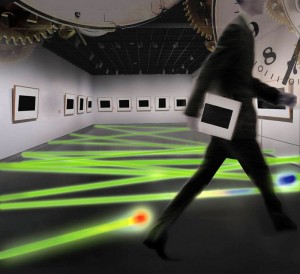
BETTER THAN HARRY POTTER’S CLOAK In this 2011 illustration, provided by Cornell University, scientists demonstrate how they have created a new invisibility technique that doesn’t just cloak an object—like in Harry Potter books and movies—but masks an entire event. It is a time masker that works by briefly bending the speed of light around an event. Cornell scientists explain what they are talking about in this 2011 illustration that shows that if this technique is ever scaled up an art thief can walk into a museum and steal a painting without setting of laser beam alarms or even showing up on surveillance cameras or your eyes. (AP Photo/Heather Deal, Cornell University)
WASHINGTON— It is one thing to make an object invisible, like boy wizard Harry Potter’s mythical cloak. But scientists have made an entire event impossible to see. They have invented a time masker.
Think of it as an art theft that takes place before your eyes and surveillance cameras. You do not see the thief strolling into the museum, taking the painting down or walking away, but he did. It’s not just that the thief is invisible — his whole activity is.
What scientists at Cornell University did was on a much smaller scale, both in terms of events and time. It happened so quickly that it is not even a blink of an eye. Their time cloak lasts an incredibly tiny fraction of a fraction of a second. They hid an event for 40 trillionths of a second, according to a study appearing in Thursday’s edition of the journal Nature.
We see events happening as light from them reaches our eyes. Usually it is a continuous flow of light. In the new research, however, scientists were able to interrupt that flow for just an instant.
Other newly created invisibility cloaks fashioned by scientists move the light beams away in the traditional three dimensions. The Cornell team alters not where the light flows but how fast it moves, changing in the dimension of time, not space.
They tinkered with the speed of beams of light in a way that would make it appear to surveillance cameras or laser security beams that an event, such as an art heist, isn’t happening.
Another way to think of it is as if scientists edited or erased a split second of history. It is as if you are watching a movie with a scene inserted that you do not see or notice. It is there in the movie, but it is not something you saw, said study co-author Moti Fridman, a physics researcher at Cornell.
The scientists created a lens of not just light, but time. Their method splits light, speeding up one part of light and slowing down another. It creates a gap and that gap is where an event is masked.
“You kind of create a hole in time where an event takes place,” said study co-author Alexander Gaeta, director of Cornell’s School of Applied and Engineering Physics. “You just don’t know that anything ever happened.”
This is all happening in beams of light that move too fast for the human eye to see. Using fiber optics, the hole in time is created as light moves along inside a fiber much thinner than a human hair. The scientists shoot the beam of light out, and then with other beams, they create a time lens that splits the light into two different speed beams that create the effect of invisibility by being too fast or too slow. The whole work is a mess of fibers on a long table and almost looks like a pile of spaghetti, Fridman said.
It is the first time that scientists have been able to mask an event in time, a concept only first theorized by Martin McCall, a professor of theoretical optics at Imperial College in London. Gaeta, Fridman and others at Cornell, who had already been working on time lenses, decided to see if they could do what McCall envisioned.
It only took a few months, a blink of an eye in scientific research time.
“It is significant because it opens up a whole new realm to ideas involving invisibility,” McCall said.
Researchers at Duke University and in Germany’s Karlsruhe Institute of Technology have made progress on making an object appear invisible spatially. The earlier invisibility cloak work bent light around an object in three dimensions.
Between those two approaches, the idea of invisibility will work its way into useful technology, predicts McCall, who was not part of either team.
The science is legitimate, but it is still only a fraction of a second, added City College of New York physicist Michio Kaku, who specializes in the physics of science fiction.
“That’s not enough time to wander around Hogwarts,” Kaku wrote in an email, referring to the fictional boarding school Harry Potter attended. “The next step therefore will be to increase this time interval, perhaps to a millionth of a second. So we see that there’s a long way to go before we have true invisibility as seen in science fiction.”
Gaeta said he thinks he can get make the cloak last a millionth of a second or maybe even a thousandth of a second. But McCall said the mathematics dictate that it would take too big a machine — about 18,600 miles (30,000 kilometers) long — to make the cloak last a full second.
“You have to start somewhere and this is a proof of concept,” Gaeta said.
Still, there are practical applications, Gaeta and Fridman said. This is a way of adding a packet of information to high-speed data unseen without interrupting the flow of information. But that may not be a good thing if used for computer viruses, Fridman conceded.
There may be good uses of this technology, Gaeta said, but “for some reason people are more interested in the more illicit applications.”

